 Use this SMR exercise AFTER you do the Lats Roll and the Pecs Hand Press (or one of it's alternatives), and in compliment with the Scalene Press. |
| For written instructions, click here For video instructions (5:51), click here (Updated video coming soon!) Click here to see all of the Extended SMR Exercises. |
| Be sure to post your questions and comments below. We want to provide the best instruction to help you recover from your workouts. **All information is provided for educational purposes only. You should consult your doctor before attempting any exercises you read on this page or any page on this website.** |
Author: Alexander Method
SMR Butterfly
 This SMR exercise addresses all of the muscles between your shoulder blade and your spine (primarily the rhomboids). If you have trouble with neck, shoulder, or upper back pain then this exercise is for you! Keep in mind that the pectoralis minor muscle is involved in everything you do that involves the shoulder blade. You will likely benefit from loosening knots in the rhomboids region, but be sure you stretch out the pec minor or your issue is likely to come right back. You should do this movement at least once every 2 weeks. (more often is better) |
|
For written instructions, click here to download a printable PDF of the SMR Butterfly For our downloadable video instruction, click here (video from 2010--updated video is in the works!) Be sure to post your questions and comments below. We want to provide the best instruction to help you recover from your workouts. Click here to return to all of the Fundamental SMR Techniques **All information is provided for educational purposes only. You should consult your doctor before attempting any exercises you read on this page or any page on this website.** |
Lats Roll
 It is likely you will need to stretch each day and possibly do other SMR movements for your "trouble areas." The movement below is part of the foundation that you build on, and you should revisit it often. |
|
For written instructions, click here to download a printable PDF of the Lats Roll
For our downloadable video instruction, click here Below is a video from our archives which we completed in 2010: |
|
Be sure to post your questions and comments below. We want to provide the best instruction to help you recover from your workouts. Click here to return to all of the Fundamental SMR Techniques **All information is provided for educational purposes only. You should consult your doctor before attempting any exercises you read on this page or any page on this website.** |
Serratus Press
 This SMR exercise more deeply addresses the 4 muscles that cross the shoulder joint on the backside of your body, plus numerous other muscles along the side & back of the ribs. If you have trouble with shoulder pain when you lift your arm, then this exercise is for you! Keep in mind that the lats and pectoralis minor muscles are involved in everything you do with the shoulder blade. You will likely benefit from loosening knots in the back of your shoulder & ribs, but be sure you stretch out the lats and the pec minor or your issue is likely to come right back. |
|
For written instructions, click here. For video instructions (3:28), click here. (Updated video coming soon!) Click here to return to all of the SMR Techniques. |
|
Be sure to post your questions and comments below. We want to provide the best instruction to help you recover from your workouts. **All information is provided for educational purposes only. You should consult your doctor before attempting any exercises you read on this page or any page on this website.** |
Scalene Press
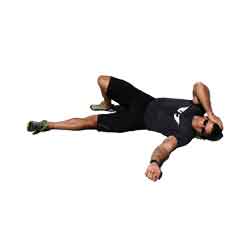 If you find your tight muscles are not relieved with the roller techniques then SLOWLY practice this deeper ball technique. You will notice a number of issues that this technique influences. The most important issue this technique can influence is poor neck posture. If you can't easily turn or tilt your head then this exercise is for you! The Neck Press technique is a natural compliment to this SMR exercise, so do them together. |
|
For written instructions, click here. For video instructions (4:11), click here. (Updated video coming soon!) Click here to see the rest of the Extended Movements. |
|
Be sure to post your questions and comments below. We want to provide the best instruction to help you recover from your workouts. **All information is provided for educational purposes only. You should consult your doctor before attempting any exercises you read on this page or any page on this website.** |
Piriformis Press
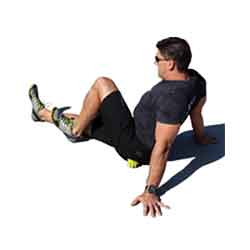 Use this SMR exercise AFTER the Quads Roll, and the Adductors Roll. |
| For written instructions, click here. For video instructions (4:43), click here. (Updated video coming soon!) Click here to see all of the SMR Exercises. |
| Be sure to post your questions and comments below. We want to provide the best instruction to help you recover from your workouts. **All information is provided for educational purposes only. You should consult your doctor before attempting any exercises you read on this page or any page on this website.** |
Glute Med Press
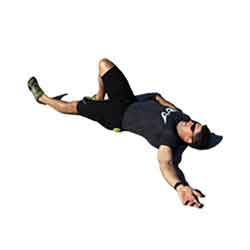 Use this SMR exercise AFTER the Quads Roll, the Adductors Roll. |
| For written instructions, click here. For video instructions (3:18), click here. (Updated video coming soon!) Click here to see all of the SMR Exercises. |
| Be sure to post your questions and comments below. We want to provide the best instruction to help you recover from your workouts. **All information is provided for educational purposes only. You should consult your doctor before attempting any exercises you read on this page or any page on this website.** |
TFL Roll
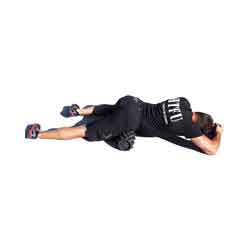 This SMR exercise is to address knots in a relatively small muscle across the front outside area of the hip. If you skip the first 2 SMR exercises for the muscles in the front and outside regions of your thigh, there is a strong likelihood of your hip discomfort coming right back. (Your center & outer quads greatly influence the load on this muscle.) If you have general tightness or discomfort in the front area of the outside of your hip, or the upper area of the outside of your thigh, then this exercise is likely to help. |
|
For written instructions, click here For video instructions (2:58), click here. (Updated video coming soon!) Click here to see the rest of the Extended Movements. |
|
Be sure to post your questions and comments below. We want to provide the best instruction to help you recover from your workouts. **All information is provided for educational purposes only. You should consult your doctor before attempting any exercises you read on this page or any page on this website.** |
TFL Press
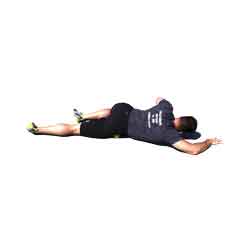 This SMR exercise is to address deeper knots in a relatively small muscle across the front outside area of the hip. If you skip the first 2 SMR exercises for the muscles in the front and outside regions of your thigh, there is a strong likelihood of your hip discomfort coming right back. (Your center & outer quads greatly influence the load on this muscle.) If you have general tightness or discomfort in the front area of the outside of your hip, or the upper area of the outside of your thigh, then this exercise is likely to help. |
|
For written instructions, click here. For video instructions (3:43), click here. (Updated video coming soon!) Click here to see the rest of the Extended Movements. |
|
Be sure to post your questions and comments below. We want to provide the best instruction to help you recover from your workouts. **All information is provided for educational purposes only. You should consult your doctor before attempting any exercises you read on this page or any page on this website.** |
Glutes Roll
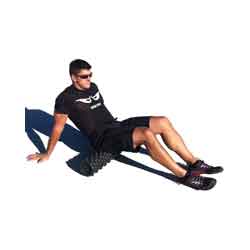 You probably won't notice knots in your buns when you are just walking around, but when you slowly roll through this tissue, you'll find them! The gluteus maximus (and many of the other posterior hip muscles) is involved in any movement using the hips. When one or more of your glutes is dysfunctional, proper hip function is compromised. You will notice a 'lightness' with body movements if you release any knots in your glutes. |
|
For written instructions, click here to download a printable PDF of the Glutes Roll For our downloadable video instruction, click here. (video from 2010--updated video is in the works!) If you have lower back issues you should begin this technique by lying flat on the floor FIRST, then lift your hips to get the roller underneath you (instead of sitting on the roller and lying back). Be sure to post your questions and comments below. We want to provide the best instruction to help you recover from your workouts. Click here to return to all of the Fundamental SMR Techniques **All information is provided for educational purposes only. You should consult your doctor before attempting any exercises you read on this page or any page on this website.** |
